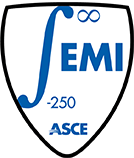Stability of Micro- and Macro- structures
University of South Brittany, France
Problems
Buckling may be the key factor in the morphogenesis of natural and biological entities (Darcy Thomson, 1959); and it is certainly a structural limit state that determines the design of many engineering structures. Buckling can occur over a large spectrum of length scales from nanotechnology investigations to the civil engineering structural design scale. Yet, a stability theory applicable to nano, micro and macro structures remains a challenge. More specifically, such a theory must be able to capture specific length scale effects at nano, micro and macro scales, in order to be applicable in both classical fields of structural engineering (timber engineering, reinforced concrete engineering, steel structures or steel‐concrete composite structures) and innovative micro‐ and nano‐engineering of structures.
Approach
We investigate the elastic and inelastic stability of small‐scale or large‐scale structures with modern mechanics concepts, such as nonlocal and non‐smooth mechanics. Such nonlocal mechanics models permit the consideration of scale transition in stability analysis, and highlight the interest of gradient and integral‐based nonlocal mechanics for engineering design. Specifically, we focus on the predictive understanding of the static and dynamic behavior of microstructured solids at small and large scales, with the help of gradient elasticity and nonlocal theories. The first theoretical results obtained for the buckling or vibrations of nonlocal columns are very recent (e.g. buckling of Eringen's column or gradient elasticity columns in 2003). The structural paradigm of Galileo's cantilever beam has been reconsidered with both nonlocal elasticity and plasticity models. Specifically, scale effects and localization propagation have been analysed for this structural problem; while nonlocality was related to the material or structural microstructure dependence.
Findings
Based on a two‐scale nonlocal model, we recently obtained a unified theory for the buckling of gradient and nonlocal elasticity beam models. Specifically, we found that this engineering model can fit well molecular dynamics data for nanoscale applications. We also noticed that composite beams with interlayer slip, sandwich beams or nanobeams are ruled by some similar nonlocal elasticity models. In other words, the stability of macroscale beam models (at the civil engineering scale) and nanoscale beam models exhibit similar scale effects, even if the source of physical nonlocality depends on the application considered. A further application of nonlocal macroscopic model is the accurate modeling of soil‐structure interaction. In this quest, we found that the Reissner soil‐structure interaction model can be classified as a two length‐scale nonlocal elasticity model. In similar developments, we identified higher‐order beam shear models as gradient elasticity Timoshenko models.
Impact
The introduction of nonlocal concepts in elastic and inelastic stability analysis of structures opens new perspectives for innovative structural design, that range from very small scale structures for e.g. nanotechnology applications, to microstructured members composed of ecomaterials or nature‐ based materials, and large scale civil engineering structures, such as repetitive frame structures. Further developments of nonlocal plasticity and damage concepts will enhance current predictive capabilities at the structural scale to account for e.g. material softening behavior, related to microcracking that may well redefine Galileo's cantilever problem.
Core competencies
- Stability of Solids and Structures;
- Continuum Damage Mechanics;
- Gradient and non‐local mechanics;
- Buckling, Post‐buckling and failure;
- Vibrations of inelastic oscillators;
- Civil Engineering and Nanomechanics
International research collaborations
- Dinar Camotim (Technical University of Lisbon): Lateral‐torsional buckling of beams.
- Isaac Elishakoff (Florida Atlantic University): Buckling of nanostructures and surface elasticity effects;
- Ulf Arne Girhammar (Luleå University of Technology): Buckling of layered members, Timber engineering;
- Jostein Hellesland (University of Oslo): Buckling of softening media and reinforced concrete design;
- C.W. Lim (City University of Hong Kong): Nonlocal beam and shell theory;
- Sid Ahmed Meftah (University of Sidi Bel Abbes): Buckling and vibrations of composite members;
- Chien‐Ming Wang (National University of Singapore): Buckling and vibrations of nonlocal structures;
- Yang Xiang (University of Western Sydney): Stability of cracked members.


